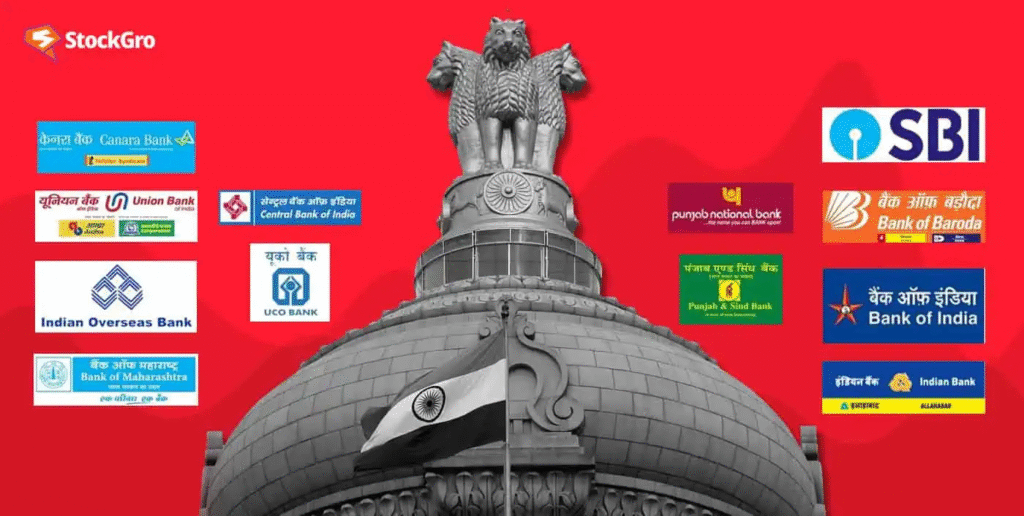Steering through Indian market volatility amid Trump’s steep tariffs? Discover why PSU banks are rallying and which sectors offer resilient opportunity.

Ever felt like Indian markets are on a slippery taxi ride, one moment revving ahead and the next skidding back? With the shadow of Trump’s punitive tariffs looming, export-led sectors are wobbling—while PSU banks are bracing for lift-off. Let’s talk about how investors can steer through this tug-of-war and find clarity in chaos.
Indian stock market volatility
Trump’s 50% Tariffs—A Storm From Across The Ocean
In early August 2025, Trump escalated tensions by doubling tariffs on Indian exports to 50%, citing India’s continued oil purchases from Russia. Export sectors like textiles, gems and jewellery, shrimp, auto components, and chemicals plunged up to 6% The Economic Times.
The Finance Ministry—already wary—warned that US policies and a slowing global economy could derail India’s export trajectory The Economic Times. Bertling the blow further, a powerful global ETF tracking Indian equities dropped 6.1% in a month, as FPIs pulled back MarketWatch.
Add fuel to that fire: foreign investor sentiment just hit a two-year low, dragged down by soaring tariffs, a weak rupee, high valuations, and tepid corporate profits The Times of India.
H3 Key takeaway:
As export-reliant sectors reel from the tariff blow, foreign capital has slowed—raising the heat on India’s economic engines.
PSU Banks—Quiet Heroes Amid the Chaos

While export-heavy segments falter, PSU banks are stealing the limelight. Today, on August 11, 2025, the Sensex rose ~250 points and the Nifty crossed 24,400, thanks to a PSU banking rally The Economic TimesReuters. SBI’s strong Q1 earnings—a 12.5% YoY jump—were the spark ReutersMarketWatch.
Expectations of a forthcoming RBI rate cut, healthy valuations, and better loan growth are fueling optimism: one session saw Rs 3.7 lakh crore added to investor wealth in the PSU bank segment MoneycontrolBusiness Standard. Technical charts add to the cheer: SBI and Canara Bank are showing bullish inverted head-and-shoulders patterns, signaling potential further upside TradingView.
Key takeaway:
With export sectors under duress, PSU banks are the sturdy lifeboat—powered by strong fundamentals, policy tailwinds, and improving charts.
India’s Macro Reality—Strong, but Slowing
Despite turbulence, India’s economy isn’t flatlining. Ashmore’s Head of Research, Gustavo Medeiros, calls the economy “robust but sequentially slowing,” urging caution due to high market valuations and tariff uncertainty The Economic Times.
Goldman Sachs projects a 0.6 percentage-point drag on GDP if the 50% tariffs remain Wall Street Journal—but RBI isn’t panicking yet, maintaining its 6.5% GDP growth forecast Financial Times.
Key takeaway:
India’s economy remains grounded but slowing—the key now is navigating risks, not overreacting.
Where Should Investors Look? Export vs Domestically-Focused Plays

Here’s how the landscape is shaping up:
Export-Heavy Sectors (Vulnerable)
- Textiles, jewellery, auto components, chemicals, and shrimp exports are hit hardest, with some stocks falling up to 6% The Economic Times.
- Trade-sensitive sectors face acute pressure amid geopolitical friction—with India accounting for 18% of its goods exports to the US—a serious vulnerability The Economic Times.
Relatively Resilient Sectors
- Analysts at Jefferies say IT services, pharma, and autos may be shielded from direct tariff impact, though a broader slowdown in the US could still dent demand Trade Brains.
Home-Grown Champions
- PSU banking is outperforming on fundamentals and momentum, as discussed above.
- A shift toward domestically-driven sectors (e.g., consumer goods, realty, infra) may offer safer ground amid global shocks.
Key takeaway:
Export-exposed sectors are under strain—defensive, domestic-oriented plays like PSU banks or IT and pharma may offer better ballast in choppy waters.
Strategic Plays for Indian Investors
Want actionable insight? Think of it like adjusting your campus commute when monsoon hits: a rainy day requires smart redirecting.
- Trim exposure to fragile, export-dependent sectors affected by tariffs.
- Boost quality PSU bank holdings—solid earnings, valuation comfort, and strong technical setup.
- Hold IT, pharma, and auto selectively—less tariff exposure, but monitor US economic signs closely.
- Diversify across domestic consumption and infra names—especially those insulated from global shocks.
- Watch macro: interest rates, FPI flows, policy shifts, and RBI guidance—these will drive the next bends in the road.
Key takeaway:
Investors should pivot like seasoned drivers—shore positions defensively and lean into domestic growth engines while monitoring external speed breakers.
Final Thoughts — Clarity in Uncertainty
2025’s market mood is like switching from cricket to kabaddi mid-match—rules are changing, turf is rougher. Yet within this turbulence, PSU banks are spiking back—with clean sheets and momentum rides—while export sectors fight headwinds.
Markets may stall—but India has runway. Tune your portfolio to adapt—not just survive.
CTA
Which sectors do you think will hold firm in the face of these tariffs? Are you shifting to PSU banks, sitting tight in pharma, or taking profits on export-heavy picks? Share your moves below—we learn together.

Are IT and pharma stocks safe from tariffs?
They’re relatively insulated from direct tariffs, but may still face headwinds if US demand slows.
What sectors are most hurt by Trump’s 50% tariffs on Indian exports?
Textiles, jewellery, shrimp, auto components, and chemicals—some saw up to a 6% slide.
How should Indian investors reposition their portfolios now?
Reduce exposure in export-reliant sectors; increase exposure to PSU banks, select IT, pharma, and domestic consumption themes.
What GDP impact could India face from these tariffs?
Goldman Sachs estimates a potential 0.6 percentage-point drag on GDP if 50% tariffs remain in place.
Why are PSU banks rallying amid market chaos?
Strong earnings, favorable valuations, RBI rate cut hopes, and positive technical formations like inverted H&S charts.